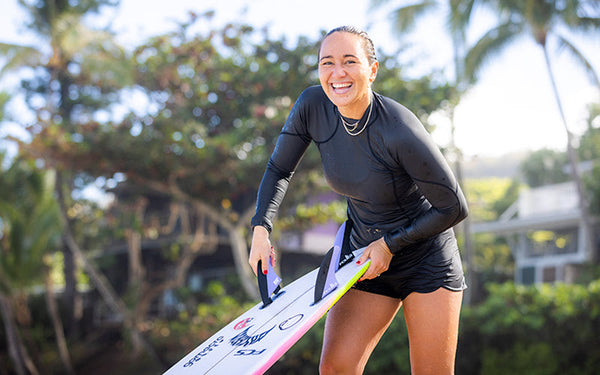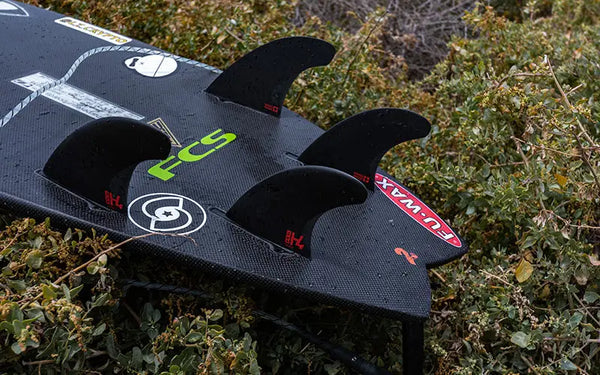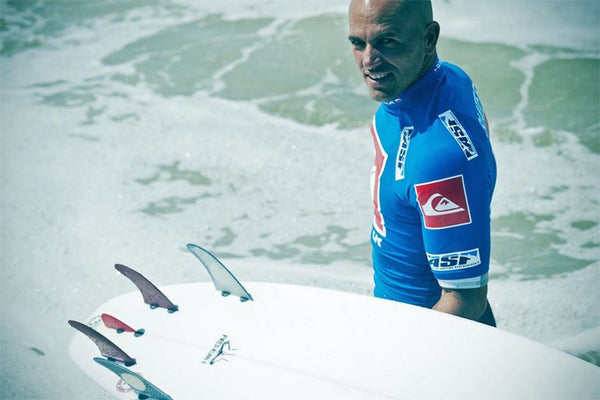The History and Practicality of the “Fifth Fin” and How Dan Mann Has Recently Been Using It as Part of His “Secret Recipe”
Share
Surfing is an ever-evolving sport, and one of the most intriguing innovations in surfboard design is the fifth fin. This additional fin has gained popularity among surfers looking to enhance their performance and control on the waves.
What is the Fifth Fin?
The fifth fin is an extra fin added to a surfboard, typically alongside the traditional thruster setup of three fins. This innovation aims to improve stability, maneuverability, and overall performance in various surf conditions.
Historical Context
The concept of adding a fifth fin to surfboards emerged in the late 20th century as surfers sought ways to optimize their boards for different wave types. Early adopters of the fifth fin noted significant improvements in their ability to carve turns and maintain speed, particularly in challenging surf conditions.
Modern shortboards have come stock with five fin boxes for the past decade or so, but choosing between a thruster or quad setup remains a major dilemma for most surfers. Both fin configurations have their pros and cons, and lend themselves toward different types of waves and styles of surfing.
Thrusters provide more control in the pocket and facilitate a top-to-bottom approach to maneuvers, but limit speed and down-the-line drive due to the drag created by the middle fin.
Around 10 years ago, a surfer from Florida named Sean Mattison started using what he called a “Nubster”—a small, low-profile center fin that helped stabilize the quad setup. This five-fin setup was a compromise between the thruster and the quad, as the small center stabilizer didn’t create as much drag (and reduced speed) as a normal center fin, but it still provided a bit of extra control for the notoriously loose quad setup.

Meanwhile, quads have extra speed and drive and can hold a rail through a carve, but tend to be loose and can spin out when pushed hard off the bottom.
While other surfers had played around with stabilizers for quads before (Pete Mel and Martin Potter called it the “guitar pick,” due to its size and shape), it wasn’t until the greatest competitive surfer on the planet started playing around with one that the world took notice. In 2012, Kelly Slater stuck a Nubster on his quad and proceeded to make the finals of the Quiksilver New York Pro on it.

FCS and Futures both began making a stabilizer option, with the spelling ultimately changing from “Nubster” to the “VS Knubster.” At the same time, Ryan Arakawa was busy creating his Vektor fin line, which includes a number of different low-profile center stabilizer fins for twins, quads, and just about any other setup where you might want some extra control in the middle.
Practical Benefits of the Fifth Fin
- Enhanced Stability: The fifth fin provides added stability, making it easier for surfers to maintain balance while riding larger waves. This stability can be particularly beneficial for beginners or those transitioning to more advanced surfing.
- Improved Maneuverability: With a fifth fin, surfers can execute sharper turns and more dynamic maneuvers. This fin configuration allows for greater responsiveness, enabling surfers to adapt quickly to changing wave conditions.
- Versatility in Different Conditions: The fifth fin setup is adaptable, allowing surfers to tackle a variety of wave types—from small, mushy waves to powerful, hollow surf. This versatility makes it an attractive option for surfers who frequent different surf spots.
- Increased Speed: Many surfers report that the fifth fin enhances their board's speed, allowing for faster rides and more exciting sessions. This speed can be a game-changer when catching waves and performing tricks.
Choosing the Right Fifth Fin
When considering adding a fifth fin to your surfboard, it’s essential to select the right fin type and size. Factors to consider include:
- Fin Material: Options include fiberglass, plastic, and carbon fiber, each offering different flex and performance characteristics.
- Fin Shape: The shape of the fin can affect how your board performs in the water. Experimenting with different shapes can help you find the perfect fit for your surfing style.
- Fin Placement: The position of the fifth fin can also influence performance. Some surfers prefer a more forward placement for increased maneuverability, while others opt for a rear placement for stability.
How do surfboard fins impact a board's performance?
Modern shortboards have come stock with five fin boxes for the past decade or so, but choosing between a thruster or quad setup remains a major dilemma for most surfers. Both fin configurations have their pros and cons and lend themselves toward different types of waves and styles of surfing.
Surfboard fins play a big role in your board's performance. Almost 40% of your board's performance is due to your fins. Switching out your fins, or your fin configuration, plays a BIG role in how your board is going to want to be surfed.
Thrusters provide more control in the pocket and facilitate a top-to-bottom approach to maneuvers, but limit speed and down-the-line drive due to the drag created by the middle fin. Meanwhile, quads have extra speed and drive and can hold a rail through a carve, but tend to be loose and can spin out when pushed hard off the bottom.
Understanding the impact of your fin setup is crucial. Experimenting with different configurations can dramatically change how your board feels under your feet and how it handles various wave conditions.
The Vektor design has a longer base than the Nubster, which tapers to a smaller tip, allowing the fin to release when desired. This gives the surfer extra control through turns, allowing them to hold a rail or blow the tail on command.
What considerations should be made when choosing fin setups for different surf conditions?
Both fin configurations have their pros and cons and lend themselves toward different types of waves and styles of surfing.
When choosing fin setups, it's essential to consider the specific surf conditions you'll be facing:
Small, Gutless Days
- Quad Trailer Fins: Positioning these closer to the rail and slightly further up can significantly loosen the board. This setup allows for quick maneuvers and makes it easier to slide the tail around as needed.
- Increased Speed: Without the resistance of a trailing center fin, you gain more speed through the flats.
Bigger, Hollow Days
- Rear Quads Positioned Back: Placing the rear fins further back and close to the rail provides extra speed and hold on the wave face. This setup is ideal for taking higher lines on steeper waves.
- Enhanced Stability: The additional hold from having two fins on the rail is crucial for maintaining speed in barreling waves where turning space is limited.
Adjusting Fin Placement
- Pivot Point: Bringing the rear fins closer together will create a pivot point similar to a center fin in a thruster set. This adjustment can alter how the board wants to be surfed, making it more responsive to turns.

Courtesy: surfertoday.com
What are the benefits of having a 5 fin convertible option on a surfboard?
Regardless of which fifth fin you choose and how you end up using it, it’s obvious that we are no longer limited to the thruster versus quad dilemma. These days, you can have a nub of cake and eat it too—or, in the case of surfboards, enjoy the best of all worlds!
Why settle for one fin setup when you can have the flexibility to switch things up? Surfing is all about experimentation, and a 5 fin convertible option opens up a world of possibilities.
- Versatility: The ability to switch between thruster, quad, and other configurations means you can adapt to different wave conditions and personal preferences.
- Minimal Downside: Extra fin boxes won't create noticeable drag or disrupt water flow under your board. You're essentially gaining options without any real drawbacks.
- Rare Limitations: While some boards are optimized for either a thruster or quad setup, this is uncommon. Most modern boards are designed to accommodate multiple configurations effectively.
The fifth fin is a valuable addition for surfers looking to enhance their performance and adaptability in the water. By understanding its history and practical benefits, you can make an informed decision about incorporating this innovative fin into your surfboard setup. Whether you're a beginner or an experienced surfer, the fifth fin could be the key to unlocking your full potential on the waves.
Check out our Fins Collection Now!
Read more related topic here:
What are the Vector System Fins?
What a Vector Fin can do on a Surfboard?
